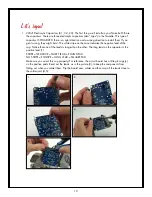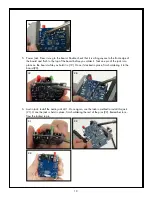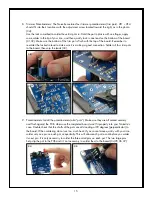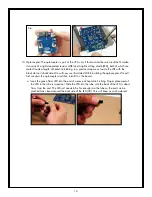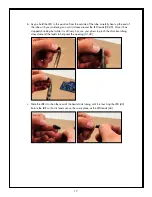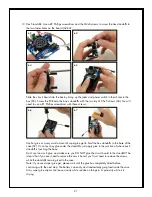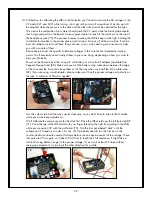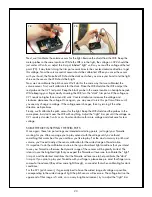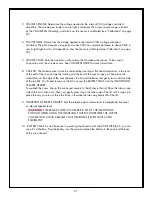
24
pot until it is as close to 5 volts as possible, without actually reaching 5 volts. Keep in mind, if
you end up using your Noisette in an environment that is brighter than the room you calibrated it
in, the pitch won’t get any higher than when CV1 is at 5 volts. So if you plan on using your
Noisette in different environments you may want to give the “light” setting a bit of headroom by
setting it lower than 5 volts.
The “dark” voltage setting of CV1 (pitch sensor) should be as low as practically possible. You’ll
notice that if you adjust the “dark” trim pot too low (while the sensor is in the dark), the voltage
of CV1 will not raise up to 5 volts when it is in the light. So then you’ll have to re-adjust the
“light” trim pot to make up for it, but there is a limit to how high you can adjust it when the
“dark” trim pot is set very low. So it becomes an iterative process of going back and forth
between adjusting the “dark” trim pot (while the sensor is covered) and then adjusting the “light”
trim pot in a bright environment until a suitably wide voltage / pitch range is reached.
For the CV2 voltage (volume sensor), the VCA circuit is controlling an LED that only starts turning
on at 1.8 volts. So the lowest voltage CV2 needs to be set to (in the darkest condition) is just
below 1.8 volts. The LED will continue getting brighter as the voltage is increased, so the
maximum voltage CV2 should be (while in the brightest light) is 5 volts. Once again, if you
calibrate your Noisette to 5 volts in a moderately bright environment, it will not get any louder in
a brighter environment. So you may want to build in some headroom by setting the bright CV2
voltage to something lower than 5 volts.
One other note to be mindful of is that you may need to readjust these settings to accommodate
how the LDRs fit in the LDR shields once the lid is in place on the Noisette. The LDR shields tend
to block more light when they are installed in the lid, as opposed to just being placed over the
LDRs when you calibrate them. So it may be helpful to set the calibration voltages slightly higher
than where you actually want them, so when the assembled lid is installed on the Noisette,
causing the LDRs to receive less light than the calibration conditions, the voltages will be closer
to where you want them.
15. Speaker Grille: Rotate the speaker grille in its hole on the lid so that the grille holes are in a
pleasing arrangement to you (75). While holding it in that position with your finger, apply a
small amount of super glue gel or hot glue on the back side to hold it in place (76).
74
75
76

